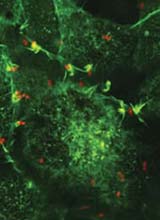Flesh-eaters make skin creep

Bacteria (red) persuade skin cells (green)to let them in. <br>© Nature <br>
Bacteria give skin cells their marching orders.
Bacteria that cause potentially lethal ’flesh-eating’ infections make their entrance by telling skin cells to step aside. The bugs hijack the body’s signal for skin cells to become mobile.
Group A streptococci (GAS) normally infect the surface lining of the throat. But occasionally they penetrate skin or the tissues lining the airways, invading deep into the body and causing life-threatening disease.
Finding out how streptococci enter tissues doesn’t reveal why merely troublesome bacteria sometimes turn lethal. But it may lead to treatments for severe infections, called necrotizing fasciitis, and sore throats.
Michael Wessels and Colette Cywes at Harvard Medical School in Boston find that GAS are covered with a cloak of molecules that mimic a signal that is normally sent to mobilize cells1. “Cells don’t know any better – they think this is a signal to get up and move,” says Wessels.
Like mortar being removed from a brick wall, the impenetrable layer of skin cells dissolves, allowing the bacteria in.
“This generates a new dogma,” says Lukas Huber, a cell biologist at the Molecular Pathology Research Institute in Vienna, Austria. Invading bacteria normally infect and destroy individual cells. “Clearly [GAS] are much smarter than that,” he says.
GAS’ deceitful cloak resembles a signalling chemical called hyaluronic acid. This is released when cells must be rearranged – to heal wounded skin, for example. “The bacteria subvert this normal function,” says Wessels.
Hyaluronic acid – or its bacterial doppelganger – binds to a receptor on the cell surface called CD44. When this happens ” the junctions [between the cells] just open,” says Huber.
Wolf in sheep’s clothing
Wessels and Cywes infected laboratory cultures of human skin with GAS. They saw the skin-cell membranes ’ruffling’, a sign that they had let go of their neighbours. A mutant form of GAS unable to produce the deceptive molecular coat was unable to penetrate skin.
Wessels and Cywes are now working to prevent GAS infection by blocking the CD44 receptors on cells, or interfering with GAS binding. They hope to gain an understanding of why GAS turn nasty, although that may have more to do with the infected individual than the bacteria, Wessels suspects.
“There are host issues that play a big role in who’s going to get the disease,” says Elaine Tuomanen, an infectious disease expert at St Jude’s Children’s Research Hospital in Memphis, Tennessee.
In the meantime, Wessel’s team hopes to develop a treatment to prevent throat infections with GAS.
“That’s certainly where the money is,” comments Tuomanen.
References
- Cywes, C. & Wessels, M. R. Group A Streptococcus tissue invasion by CD44-mediated cell signalling. Nature, 414, 648 – 652, (2001).
Media Contact
More Information:
http://www.nature.com/nsu/011206/011206-12.htmlAll latest news from the category: Life Sciences and Chemistry
Articles and reports from the Life Sciences and chemistry area deal with applied and basic research into modern biology, chemistry and human medicine.
Valuable information can be found on a range of life sciences fields including bacteriology, biochemistry, bionics, bioinformatics, biophysics, biotechnology, genetics, geobotany, human biology, marine biology, microbiology, molecular biology, cellular biology, zoology, bioinorganic chemistry, microchemistry and environmental chemistry.
Newest articles

Silicon Carbide Innovation Alliance to drive industrial-scale semiconductor work
Known for its ability to withstand extreme environments and high voltages, silicon carbide (SiC) is a semiconducting material made up of silicon and carbon atoms arranged into crystals that is…

New SPECT/CT technique shows impressive biomarker identification
…offers increased access for prostate cancer patients. A novel SPECT/CT acquisition method can accurately detect radiopharmaceutical biodistribution in a convenient manner for prostate cancer patients, opening the door for more…

How 3D printers can give robots a soft touch
Soft skin coverings and touch sensors have emerged as a promising feature for robots that are both safer and more intuitive for human interaction, but they are expensive and difficult…





















